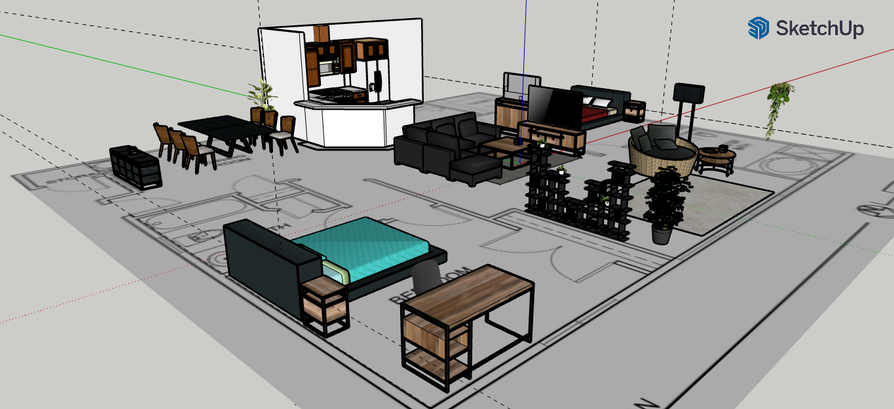ARID 1120
Restricted to interior design majors.
An introductory course focusing on understanding elements and principles of interior design and art, with an emphasis on relationships among behavior, the built environment, sustainability, and green design.
[Aligned with selected VSU General Education Outcomes, CIDA, and NASAD Standards]
Upon successful completion of this course;
VSU General Education Outcomes
-
Students will express themselves clearly, logically and precisely in writing and in speaking, and they will demonstrate competence in reading and listening. (VSU)
-
Students will demonstrate the ability to analyze, to evaluate, and to make inferences from oral, written and visual materials. (VSU)
-
Students will use computer and information technology when appropriate. (VSU)
NASAD Standards
-
Gain functional competence with principles of visual organization, including the ability to work with visual elements in two and three dimensions; color theory and its applications; and drawing.
-
Present work that demonstrates perceptual acuity, conceptual understanding, and technical facility at a professional entry level in their chosen field(s).
-
Students must demonstrate achievement of professional, entry-level competence in the major area of specialization, including significant technical mastery, capability to produce work and solve professional problems independently, and a coherent set of artistic/intellectual goals that are evident in their work.
-
Students must have the ability to form and defend value judgments about art and design and to communicate art/design ideas, concepts, and requirements to professionals and laypersons related to the practice of the major field. They are able to work collaboratively as appropriate to the area(s) of specialization.
-
Ability to conceive of and design for interior spaces, incorporating and integrating the knowledge and skills listed in Standards for Accreditation
-
Understanding of the basic principles and applications of design and color in two and three dimensions, particularly with regard to human response and behavior. Design principles include, but are not limited to, an understanding of basic visual elements, principles of organization and expression, and design problem solving.
-
Ability to apply design and color principles in a wide variety of residential and nonresidential projects. This requires an in-depth knowledge of the aesthetic and functional properties of structure and surface, space and scale, materials, furniture, artifacts, textiles, lighting, acoustics, heating and cooling systems, air quality systems, and the ability to research and solve problems creatively in ways that pertain to the function, quality, and effect of specific interior programs.
-
Understanding of the technical issues of human factors and basic elements of human behavior, including areas such as programming, environmental control systems, anthropometrics, ergonomics, proxemics, wayfinding, sustainability, universal design, and design for the physically/mentally challenged. In making design decisions, the ability to integrate human-behavior and human-factor considerations with project goals and design elements is essential.
-
Knowledge of the technical aspects of construction and building systems, and energy conservation, as well as working knowledge of applicable legal codes, contract documents, specifications protocols, schedules, and regulations related to construction, environmental systems, accessibility, and human health and safety, and the ability to apply such knowledge appropriately in specific design projects.
-
Ability to hear, understand, and communicate to the broad range of professionals and clients involved or potentially involved the concepts and requirements of interior design projects. Such communication involves verbal, written and representational media in both two and three dimensions and encompasses a range from initial sketch to finished design.
-
The ability to gather information, conduct research, and apply research and analysis to design projects. Familiarity with research theories and methodologies related to or concerned with interior design is essential.
CIDA Standards
-
Standard 4. Global Context. Interior designers have a global view and consider social, cultural, economic, and ecological contexts in all aspects of their work.
-
Standard 5. Collaboration. Interior designers collaborate and participate in interdisciplinary teams.
-
Standard 6. Business Practices and Professionalism. Interior designers understand the principles, processes, and responsibilities that define the profession and the value of interior design to society.
-
Standard 7. Human-Centered Design. Interior designers apply knowledge of human experience and behavior to designing the built environment.
-
Standard 8. Design Process. Interior designers employ all aspects of the design process to creatively solve a design problem.
-
Standard 9. Communication. Interior designers are effective communicators.
-
Standard 11. Design Elements and Principles. Interior designers apply elements and principles of design.
-
Standard 12. Light and Color. Interior designers apply the principles and theories of light and color effectively in relation to environmental impact and human wellbeing.
-
Standard 13. Products and Materials. Interior designers complete design solutions that integrate furnishings, products, materials, and finishes.
-
Standard 14. Environmental Systems and Human Wellbeing. Interior designers use the principles of acoustics, thermal comfort, indoor air quality, and water and waste systems in relation to environmental impact and human wellbeing.
-
Standard 15. Construction. Interior designers understand interior construction and its interrelationship with base building construction and systems.
-
Standard 16. Regulations and Guidelines. Interior designers apply laws, codes, standards, and guidelines that impact human experience of interior space.

